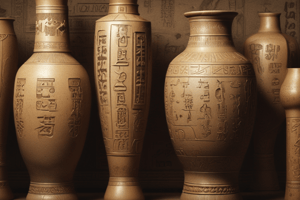Podcast
Questions and Answers
Thời gian tồn tại của triều đại nhà Thương từ năm nào đến năm nào?
Thời gian tồn tại của triều đại nhà Thương từ năm nào đến năm nào?
- 1800 TCN đến 1200 TCN
- 1600 TCN đến 1046 TCN (correct)
- 1400 TCN đến 1000 TCN
- 2000 TCN đến 1500 TCN
Triều đại nhà Thương thuộc loại hình chính quyền nào?
Triều đại nhà Thương thuộc loại hình chính quyền nào?
- Chính quyền quân chủ tập quyền (correct)
- Chính quyền lâm thời
- Chính quyền phong kiến
- Chính quyền cộng hòa
Ai là vị vua nổi tiếng nhất trong triều đại nhà Thương?
Ai là vị vua nổi tiếng nhất trong triều đại nhà Thương?
- Vua Wu Ding (correct)
- Vua Jie
- Vua Wen
- Vua Qin Shi Huang
Nguyên nhân chính dẫn đến sự sụp đổ của triều đại nhà Thương là gì?
Nguyên nhân chính dẫn đến sự sụp đổ của triều đại nhà Thương là gì?
Đặc điểm văn hóa nổi bật nào gắn liền với triều đại nhà Thương?
Đặc điểm văn hóa nổi bật nào gắn liền với triều đại nhà Thương?
Flashcards
Triều đại nhà Thương
Triều đại nhà Thương
Triều đại nhà Thương là một triều đại trong lịch sử Trung Quốc, tồn tại từ khoảng năm 1600 TCN đến năm 1046 TCN.
Văn minh nhà Thương
Văn minh nhà Thương
Thời kỳ nhà Thương được đánh dấu bởi sự phát triển văn minh, bao gồm chữ viết, nông nghiệp, đồ gốm, đồng thau và các công trình kiến trúc.
Thương vương
Thương vương
Các vua nhà Thương được gọi là "Thương vương", và họ là những người cai trị tuyệt đối.
Lễ nghi và tín ngưỡng nhà Thương
Lễ nghi và tín ngưỡng nhà Thương
Signup and view all the flashcards
Kết thúc nhà Thương
Kết thúc nhà Thương
Signup and view all the flashcards
Study Notes
Overview of the Shang Dynasty
- The Shang dynasty, also known as the Yin dynasty, ruled ancient China roughly from 1600 to 1046 BCE.
- It represents a significant stage in Chinese history, marking a transition from a largely Neolithic society to one with a more complex political and social structure.
- Archaeological evidence, particularly oracle bones, provides a wealth of information about Shang culture and governance.
Political Structure and Governance
- The Shang dynasty was a centralized monarchy, with the king at the apex of power.
- Evidence suggests a hierarchical system, with various officials and nobles holding positions of authority, likely responsible for administering specific regions or tasks.
- Kingship was considered divinely ordained, potentially reflecting a religious rationale for political authority.
- Powerful military forces were likely utilized to maintain control and suppress opposition, facilitating the expansion of Shang territory.
Economy
- Agriculture was the primary economic activity of the Shang people.
- Evidence suggests the existence of a well-organized agricultural system, potentially involving centralized control or taxation of agricultural output.
- Evidence also indicates the use of bronze technology, which was crucial for tools and weaponry, suggesting a level of technological advancement and specialization.
- Evidence of trade networks, including the exchange of materials like jade and bronze, exists, signaling interaction with surrounding cultures.
Society and Culture
- Shang society exhibited social stratification, with distinct classes of elites and commoners.
- The elites, including the ruling class, controlled resources and power.
- The common people primarily engaged in agricultural labor.
- Sophisticated bronze casting techniques were developed, producing exquisite ritual vessels, implying a strong religious component influencing arts and crafts.
- Burial practices reflect social hierarchy, as elaborate tombs for elites indicate a differentiated status system.
Religion and Beliefs
- Ancestor veneration was a central aspect of Shang religion.
- Oracle bones, used for divination, provide crucial insights into Shang religious practices and beliefs.
- Religious beliefs were integral to shaping societal structures and political authority.
- A complex pantheon of gods and spirits likely existed. The spirits of ancestors were believed to influence the present.
Technology and Innovation
- Advancements in bronze casting during the Shang dynasty were remarkable.
- The production of bronze vessels and implements reveals a high level of metalworking skill.
- The development of writing on oracle bones is a crucial technological advancement, enabling documentation of historical events and religious practices.
- The Shang used advanced techniques for agriculture and governance, suggesting advanced knowledge of observation.
Decline and Fall
- The Shang dynasty's decline is attributed to a combination of factors. This includes internal conflicts, potential environmental shifts, and likely pressures from neighboring groups.
- The Zhou dynasty emerged and gradually gained power, eventually replacing the Shang dynasty through conquest.
- The precise details of the fall of the Shang remain debated by historians.
Conclusion
- The Shang dynasty was a pivotal period in the development of ancient China, laying the groundwork for many aspects of later Chinese culture.
- The abundance of archaeological evidence illuminates significant advancements in technology, political organization, social stratification, and religious beliefs.
- Understanding the Shang dynasty is essential for comprehending the origins and evolution of Chinese civilization.
Studying That Suits You
Use AI to generate personalized quizzes and flashcards to suit your learning preferences.




